High Impact Tutoring Built By Math Experts
Personalized standards-aligned one-on-one math tutoring for schools and districts
In order to access this I need to be confident with:
Two step word problems

Two-step word problems
Here you will learn about two-step word problems, including how to solve a two-step word problem, how to represent these problems using equations, and how to assess the reasonableness of answers.
Students will first learn about two-step word problems as part of operations and algebraic thinking in 3 rd grade and will continue using this skill throughout elementary and middle school.
What are two-step word problems?
Two-step word problems are word problems or story problems that require two steps to find the answer. These two steps can involve the same operation or two different operations.
To solve a two-step word problem, you must read the problem carefully before identifying each of the two steps. After identifying the two steps, you can write an equation for each step. Then you will need to solve each equation in order before arriving at the final answer.
For example,
Sarah had \$15. She spent \$8 on a new book. Then her mom gave her \$5. How much money does she have now?
We can break down the problem into steps and write an equation.
Sarah starts with \$15, so this is the starting number.
Then she spends \$8 on a new book. This means you need to subtract \$8. This is step one .
x represents the amount of money Sarah has after buying the book.
Next, Sarah receives \$5 from her mom. This needs to be added to the remaining amount from step one. This is step two .
t represents the total of money Sarah has after her mom gave her \$5 .
Sarah has \$12 now.
You can also write an equation showing both steps and use the order of operations rules to solve.

After solving the problem, you should ask yourself: Is my answer reasonable?
You can use quick mental math or estimation to see if your answer is reasonable.
You can round the \$8 to \$10 to make the estimation easier.
\$15-\$10 + \$5 = \$10, so Sarah has about \$10 left. This means the answer of \$12 is reasonable.
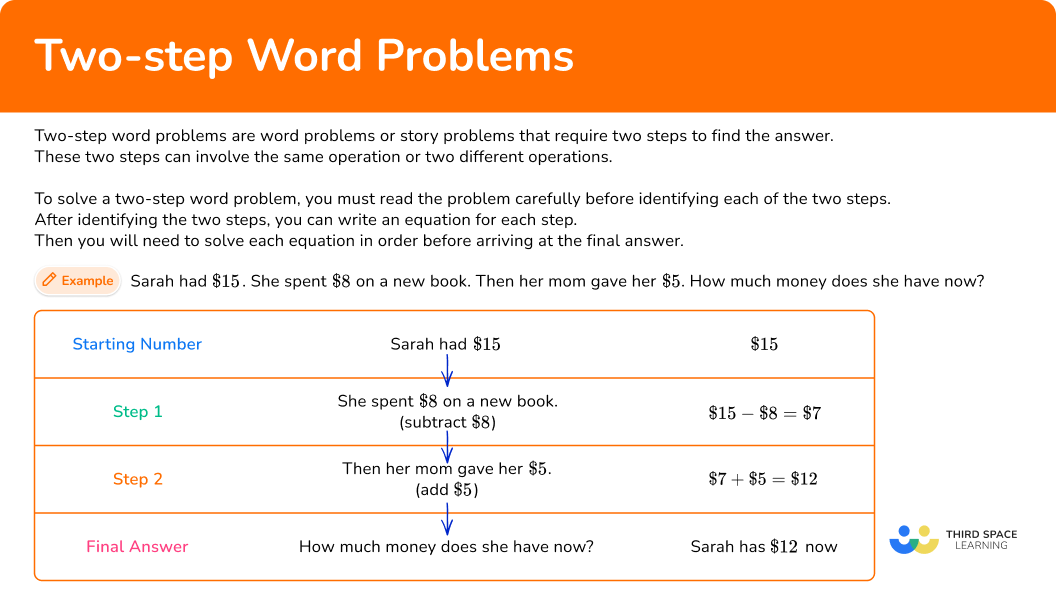
[FREE] Arithmetic Worksheet (Grade 4 to 6)
Use this quiz to check your grade 4 to 6 students’ understanding of arithmetic. 10+ questions with answers covering a range of 4th, 5th and 6th grade topics to identify areas of strength and support!
Common Core State Standards
How does this relate to 3 rd grade math and 4 th grade math?
- Grade 3 – Operations and Algebraic Thinking (3.OA.D.8) Solve two-step word problems using the four operations. Represent these problems using equations with a letter standing for the unknown quantity. Assess the reasonableness of answers using mental computation and estimation strategies including rounding.
- Grade 4 – Operations and Algebraic Thinking (4.OA.A.3) Solve multistep word problems posed with whole numbers and having whole-number answers using the four operations, including problems in which remainders must be interpreted. Represent these problems using equations with a letter standing for the unknown quantity. Assess the reasonableness of answers using mental computation and estimation strategies including rounding.
How to solve two-step word problems
In order to solve two-step word problems:
Identify the first step and write an equation.
Identify the second step and write an equation.
Solve the equations in order.
Assess the reasonableness of your answer.
Two-step word problems examples
Example 1: two-step addition (same operation).
Hannah bought 2 bags of candy for trick-or-treaters. One bag had 78 pieces of candy and the other had 92 pieces of candy. Hannah’s friend came over and dumped another bag of candy in the bowl. This bag had 124 pieces of candy. How many pieces of candy are in the bowl altogether?
First, you need to find out the total number of pieces Hannah dumped into the bowl from her two bags.
2 Identify the second step and write an equation.
Next, you need to add the total pieces that Hannah’s friend dumped into Hannah’s total from the previous step.
3 Solve the equations in order.
There are a total of 294 pieces of candy in the bowl.
4 Assess the reasonableness of your answer.
You can use mental math or estimation to see if your answer is reasonable.
You can quickly round each number to 100, which gives you a total of 300 pieces of candy. This is close to the actual answer of 294, so the answer is reasonable.
Example 2: two-step problem (different operation)
A teacher ordered 8 new boxes of pencils for her classroom. Each box of pencils had 16 pencils. She decided to combine all of the pencils, and then split them evenly between the 4 student tables in the room. How many pencils will each table get?
First, you need to find the total number of pencils in all the boxes.
8 \times 16=x
Next, you need to divide the total number of pencils by the number of tables.
Each table will get 32 pencils.
8 \times 20= about 160 total pencils divided by 4 tables = about 40 pencils on each table. So the answer of 32 is reasonable.
Example 3: solving two-step word problems with fractions
A cookie recipe calls for \cfrac{1}{2} cup of white sugar and \cfrac{3}{4} cup of brown sugar.
The baker is making 6 batches of cookies. What is the total amount of sugar (white and brown) that will be used?
First, you need to add the amounts of sugar to find the total amount of sugar needed for 1 batch.
\cfrac{1}{2}+\cfrac{3}{4}=x
Next, you need to multiply the total amount of sugar by the number of batches being made.
x \times 6=s
7 \cfrac{1}{2} total cups of sugar will be needed for 6 batches of cookies.
\cfrac{1}{2} and \cfrac{3}{4} is a little more than 1 cup.
Since there will be 6, the answer will be more than 6 cups.
Therefore, the answer of 7 \cfrac{1}{2} cups is reasonable.
Example 4: solving two-step word problems with decimals
Chris makes \$12.50 an hour at his job at the roller skating rink. He worked 25 hours. After he got his paycheck, he spent \$65 on a new pair of shoes. How much money does he have left from his paycheck?
First, you need to find out how much money Chris’s paycheck was by multiplying the hourly rate by the number of hours he worked.
12.50 \times 25=x
Next, you need to subtract \$65 from the total paycheck amount.
Chris has \$247.50 left from his paycheck.
To estimate the amount of Chris’s paycheck, you can multiply 12 by 25. You could also multiply 12 by 30, but note this will be a high estimate.
12 \times 25=300-65 = \$235 which makes \$247.50 a reasonable answer.
Example 5: interpreting remainders in two-step division word problem
Five 5 th grade classes each have 24 students and 2 teachers attending a field trip. Each bus can hold 48 people. How many buses are needed to carry all of the students and teachers to the field trip?
First, you need to find out how many students and teachers are attending the field trip altogether. To do this, you will need to multiply 5 \times 26.
5 \times 26=x
Next, you need to divide the total number of people by the number of people each bus can carry.
x \div 48=b
Now that you have identified the steps, you can solve the equations in order.
For this problem, you will need to refer back to the question in order to interpret the remainder. It asks: How many buses are needed to carry all of the students and teachers to the field trip?
So in this word problem, the answer 2 \; R \, 34 represents 2 full buses with 34 people leftover. Since those 34 people also need a bus to ride to the field trip, you would round up the answer to 3 so that all people can attend the field trip.
3 buses are needed to carry all of the students and teachers to the field trip.
There are about 125 people attending the field trip (about 25 people \times 5 classes) and about 50 people can fit on a bus. 125 \div 50=2.5, so the answer of 3 buses is reasonable.
Example 6: interpreting remainders in two-step division word problems
Haruki had 39 books. He got 7 more books for his birthday. His bookshelf has 4 shelves. He wants to put the same number of books on each shelf and put the remaining books on top of his bookshelf. How many books will go on top of Haruki’s bookshelf?
First, you need to determine how many books Haruki has altogether.
So step 1 is to add to find the total number of books.
Next, you will need to divide the total number of books by the number of shelves Haruki has.
For this problem, you will need to refer back to the question in order to interpret the remainder. It asks: How many books will go on top of Haruki’s bookshelf?
So in this word problem, the remainder is your answer.
2 books will go on top of Haruki’s bookshelf.
Haruki has about 45 books that he wants to divide equally between 4 shelves, which means there would be about 11 books on each shelf with about 1 left over. So the answer of 2 books is reasonable.
Teaching tips for two-step word problems
- Begin with simple 2 -step word problems on math worksheets that involve familiar situations and basic operations. Gradually increase the complexity as learners gain confidence and understanding.
- Lesson plans should involve step-by-step problem-solving strategies, such as underlining important information, identifying keywords, and breaking the problem into smaller parts. Model how to solve each step before tackling the problem as a whole.
- Connect math word problems to real-life scenarios that are relevant and interesting to students. This can help them see the practical application of math and reasoning skills and increase engagement on word problem worksheets.
- Provide students with a template if needed to help them break down the problem into steps. You can also provide students with a printable answer key to check their work. If their answers do not match, they can go back to investigate and find the correct steps.
- Start with simple two-step word problems with 1 -digit numbers to allow students to focus on identifying the two steps. Then advance to 2 -digit and 3 -digit problems.
Easy mistakes to make
- Incorrect order of operations Students might perform operations in the wrong order, leading to incorrect solutions. It is imperative that students write their equations correctly to ensure the operations are performed in the correct order.
- Not checking the solution Sometimes, students may not take the time to review their solution to ensure it makes sense in the context of the problem. Checking the answer against the problem statement or using estimation to verify reasonableness can help catch errors.
- Missing a step or performing the steps in the wrong order Sometimes, students may misinterpret the problem statement, causing them to miss a step or mix up the order of steps. It’s crucial to carefully read and understand what the problem is asking for before attempting to solve it.
Related arithmetic lessons
- Skip counting
- Number sense
- Inverse operations
- Money word problems
- Calculator skills
Practice two-step word problem questions
1. Frankie has \$287 in her checking account. She spent \$56 on her phone bill and then spent \$39 at dinner. How much money is left in her account?

This is a two-step subtraction word problem, meaning each of the two steps involves subtraction.
1 st step: Subtract the amount spent on the phone bill.
2 nd step: Subtract the amount spent at dinner from what is left after step 1.
2. Elliot has 145 marbles in his collection. He lost 18 marbles and then bought 27 more. How many marbles does he have now?
154 marbles
190 marbles
136 marbles
100 marbles
This two-step word problem involves two different operations.
1 st step: Subtract the number of marbles Elliot lost.
2 nd step: Add the number of marbles Elliot bought to the total remaining marbles from step 1.
127 + 27 = 154 marbles
3. Mrs. Smith baked 24 cookies in the morning and 18 cookies in the afternoon. If she wants to pack them into bags of 6 cookies each, how many bags of cookies will she have in total?
1 st step: Find the total number of cookies Mrs. Smith baked.
2 nd step: Divide the total number of cookies by the number of cookies per bag to find the total number of bags.
42 \div 6=7 bags
4. Sarah has 15 comic books. She decides to buy 5 more comic books at the store. Each comic book costs \$3.50. If she also buys a poster for \$8, how much money will Sarah spend in total?
This two-step word problem involves two different operations. Also note that there is an extra bit of unnecessary information in the word problem (Sarah has 15 comic books).
1 st step: Determine the total cost of the comic books Sarah buys.
2 nd step: Add the amount spent on the poster to the total from step 1.
5. Libby is selling boxes of cookies for a fundraiser at her school. So far, she has sold 29 boxes of cookies for \$12 each. If she has a goal of raising \$400, how much more money does she need to earn?
1 st step: Multiply to find the amount Libby earned from selling 29 boxes of cookies.
2 nd step: Determine how much more money Libby needs to earn to reach her goal by subtracting the total from step 1 from her goal amount.
6. Georgio has 128 complete fossils in his collection. He donated 19 fossils to a local museum. He wants to arrange the rest of his fossils in a display case in his house. The display case has 7 shelves. If he wants to put the same number of fossils on each shelf, how many will go on each shelf?
1 st step: Subtract to find the number of fossils remaining after donating to the museum.
2 nd step: Determine how many fossils Georgio can put on each shelf by dividing the remaining fossils by the number of shelves.
Two-step word problems FAQs
To solve a two-step word problem, you must read the problem carefully before identifying each of the two steps. After identifying the two steps, you can write an equation. Then you will need to perform each step in the correct order before arriving at the final answer.
The next lessons are
- Properties of equality
- Types of numbers
- Rounding numbers
- Factors and multiples
Still stuck?
At Third Space Learning, we specialize in helping teachers and school leaders to provide personalized math support for more of their students through high-quality, online one-on-one math tutoring delivered by subject experts.
Each week, our tutors support thousands of students who are at risk of not meeting their grade-level expectations, and help accelerate their progress and boost their confidence.

Find out how we can help your students achieve success with our math tutoring programs .
[FREE] Common Core Practice Tests (3rd to 8th Grade)
Prepare for math tests in your state with these 3rd Grade to 8th Grade practice assessments for Common Core and state equivalents.
Get your 6 multiple choice practice tests with detailed answers to support test prep, created by US math teachers for US math teachers!
Privacy Overview

Word Problems Worksheets
Two step equations word problems worksheets.
This two step word problems worksheet will produce ten problems per worksheet. You may select the numbers to be represented with digits or in words. You may increase the difficulty by selecting extra unnecessary information.
Format for the Numbers Used in the Word Problems
Represent Numbers with Digits Represent Numbers with Words Mixture of Both Formats
Language for the Worksheet
Memo Line for the Worksheet
You may enter a message or special instruction that will appear on the bottom left corner of the Worksheet.

Worksheet Answer Page
Include Worksheet Answer Page
Now you are ready to create your Worksheet by pressing the Create Button.
Two-Step Equations
Solving two-step equations.
There is no doubt that solving a two-step equation is extremely easy. As the name implies, two-step equations can be solved in just two steps. If this is your first encounter with two-step equations, don’t worry because we will go over enough examples to make you familiar with the process.
When solving an equation in general, we always keep in mind the notion that whatever we do to one side of the equation should also be done to the other side to ensure that the equation remains balanced.
We know that we have completely solved a two-step equation if the variable, usually represented by a letter in an alphabet, is isolated on one side of the equation (either left or right) and the number is located on the opposite side.
The USUAL way of solving a two-step equation:
Note : This is the “usual” method because most of the two-step equations are solved this way. Notice that Step 2 can alternatively be replaced by Step 3 which are the same essentially.
1) First, add or subtract both sides of the linear equation by the same number.
2) Secondly, multiply or divide both sides of the linear equation by the same number.
3)* Instead of step #2, always multiply both sides of the equation by the reciprocal of the coefficient of the variable.
Examples of How to Solve Two-Step Equations
Example 1: Solve the two-step equation below.
As the name of this linear equation suggests, it requires two steps in order to solve for the unknown variable. Generally, the first step involves getting rid of the number “farthest” from the term with a variable being solved. Then, we eliminate the number “closest” to the variable. The number is either multiplying or dividing the variable. It is also called the coefficient of the term.
The variable here is [latex]x[/latex]. Our goal is to solve [latex]x[/latex] by isolating it on one side of the equation. Keeping the variable on the left or on the right doesn’t make any difference. It is up to you! In this problem, let’s keep it on the left side since it’s already there.
On the side (left side of the linear equation) where the variable is located, notice that [latex]2[/latex] is “closest” to variable [latex]x[/latex], and [latex]5[/latex] is “farthest” one.
This simple observation allows us to decide which number to eliminate first. It is obviously [latex]+5[/latex] because it is farther between the two. The opposite of [latex]+5[/latex] is [latex]-5[/latex], that means we will subtract both sides of the equation by [latex]5[/latex].
After eliminating [latex]5[/latex] on the left side of the equation by subtracting both sides by [latex]5[/latex], it’s time to get rid of the number closest or directly attached to [latex]x[/latex] which is [latex]2[/latex] in [latex]2x[/latex]. Since [latex]2[/latex] is multiplying the variable [latex]x[/latex], its opposite operation is to divide by [latex]2[/latex].
After dividing both sides by [latex]2[/latex], we obtain the final answer or solution to the given two-step linear equation.
Just a quick reminder, it is considered solved because the coefficient of the variable is just positive one, [latex]+1[/latex].
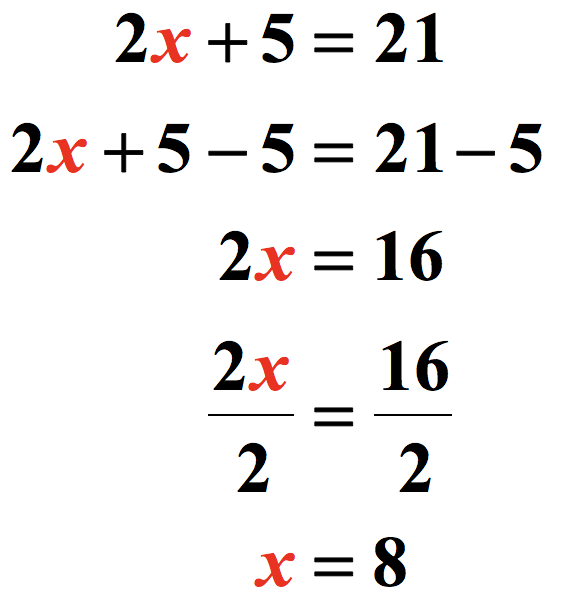
Example 2: Solve the two-step equation below.
Our goal is to keep the variable [latex]x[/latex] on one side of the equation. It doesn’t matter which side, however it is a “standard” practice to keep the variable being solved to the left side. Some algebra teachers may require you to keep the variable to the left and there’s nothing with that. Personally, I don’t mind where you keep the variable, either left or right, as long as the isolated variable on one side of the equation has a coefficient of [latex]+1[/latex].
The first step involves removing the number “farthest” from variable [latex]x[/latex]. Notice that [latex]-3[/latex] is “closest” to [latex]x[/latex], while [latex]-8[/latex] is “farther away”. So then, we can eliminate [latex]-8[/latex] by adding to its opposite which is [latex]+8[/latex].
The second step involves getting rid of the number closest to the variable [latex]x[/latex] which is [latex]-3[/latex]. Since [latex]-3[/latex] is multiplying the variable x, its opposite operation is to divide by [latex]-3[/latex]. After dividing both sides by [latex]-3[/latex], we have solved the linear equation.
Quick reminder, [latex]-3[/latex] divided by [latex]-3[/latex] is equal to [latex]+1[/latex].
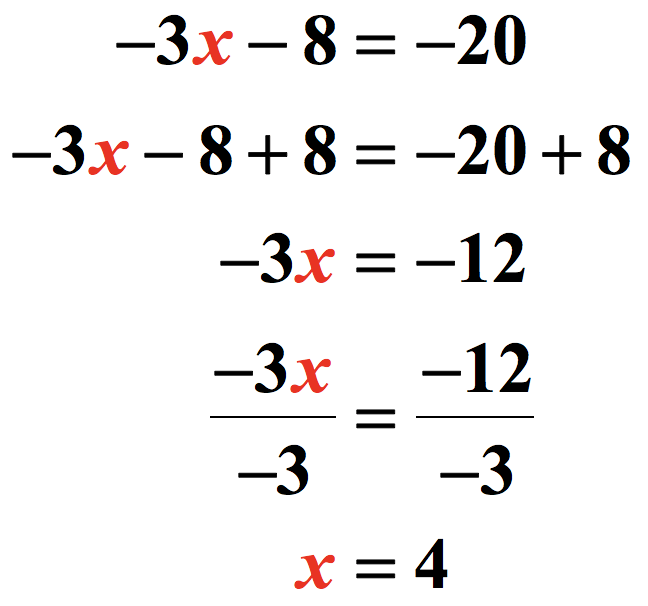
Example 3: Solve the two-step equation below.

Here’s a situation where we can isolate the variable [latex]x[/latex] to the right side of the equation since it is already there.
Looking at the right side of the equation where the variable is located, the number [latex]3[/latex] is closest to [latex]x[/latex] because [latex]3[/latex] is dividing the variable [latex]x[/latex]. On the other hand, the number [latex]26[/latex] is “farther away”. This implies that we will have to deal with [latex]+26[/latex] by subtracting both sides of the equation by [latex]26[/latex]. The reason we subtract is that the additive inverse of [latex]+26[/latex] is [latex]-26[/latex].
The second step is to get rid of the denominator [latex]3[/latex]. Since [latex]3[/latex] is dividing the [latex]x[/latex], its opposite operation is to multiply by [latex]3[/latex].
After multiplying both sides by [latex]3[/latex], we have arrived at the final answer. You may rewrite your final answer as [latex]x = -9[/latex].
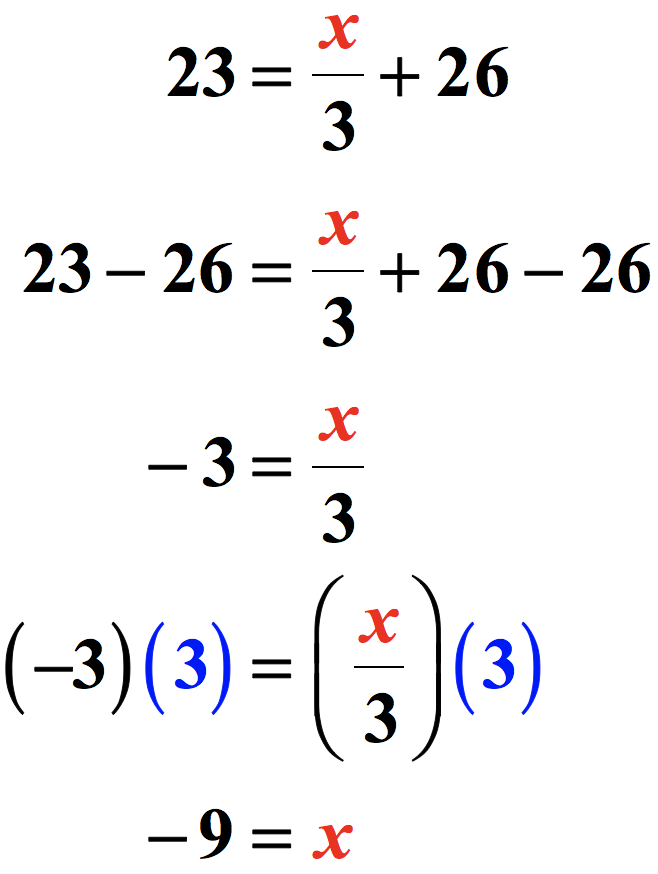
Example 4: Solve the two-equation below.
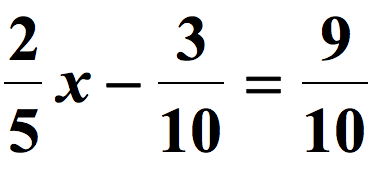
This may appear to be a multi-step equation, but it is not. It can be solved in two steps. Don’t be bothered by the fractions because they are very easy to deal with. In this case, you will apply the rule of fraction addition. The rule states that if you are adding two fractions that have the same denominator, just add the numerators then copy the common denominator.
Back to solving the two-step equation above, to remove the fraction on the left side which is [latex]\Large{ – {3 \over {10}}}[/latex], we will add [latex]\Large{{3 \over {10}}}[/latex] to both sides of the equation.
The reason that we are adding instead of subtracting is because the additive inverse of [latex]\Large{ – {3 \over {10}}}[/latex] is [latex]\Large{+ {3 \over {10}}}[/latex] .
After adding [latex]\Large{{3 \over {10}}}[/latex] to both sides, only [latex]{\Large{{2 \over 5}}}x[/latex] remains on the left side.
For the right side of the equation, we have [latex]\Large{{9 \over {10}} + {3 \over {10}} = {{12} \over {10}}}[/latex].
Everything I stated above is just the first step. Now, moving on to the second step. Look at the coefficient of the variable [latex]x[/latex]. It is [latex]\Large{{2 \over 5}}[/latex] that means its reciprocal is [latex]\Large{{5 \over 2}}[/latex].
To finally solve the given equation, we will multiply both sides of the equation by the reciprocal of the coefficient of the variable in question. Here’s the complete step-by-step solution:
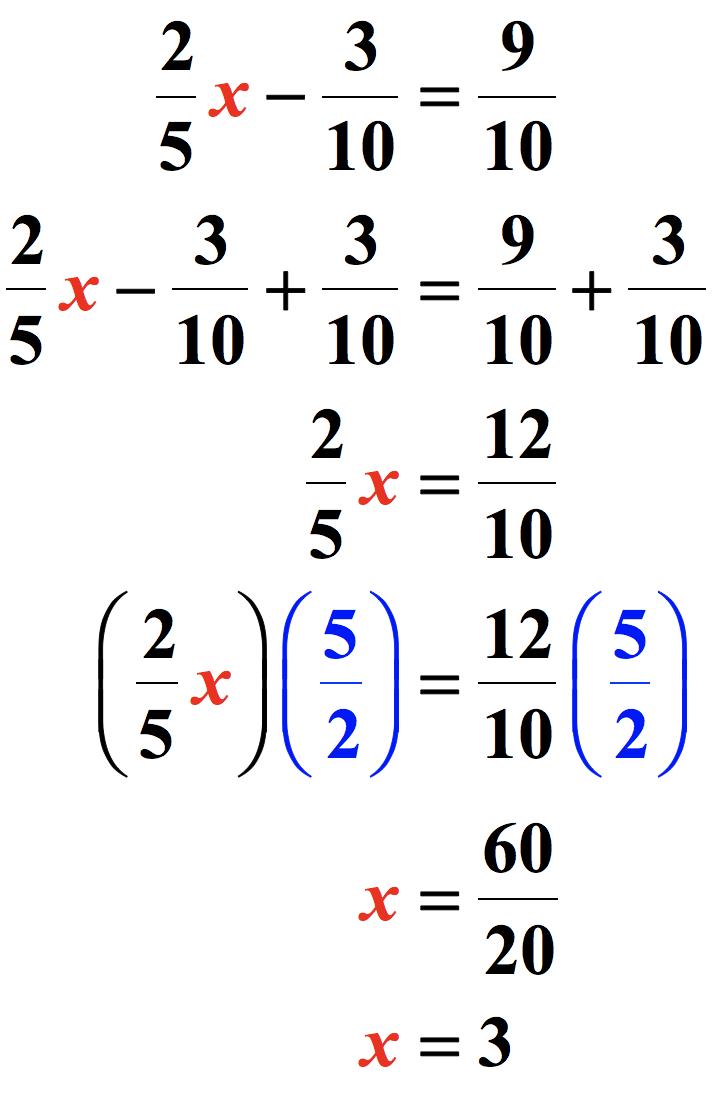
Take a quiz:
- Two-Step Equations Quiz
You might also like these tutorials:
- Two-Step Equations Practice Problems with Answers
- Multi-Step Equations Practice Problems with Answers
2-Step Word Problems Worksheet
Related Topics & Worksheets: Math Worksheets Printable Math Worksheets Free Online Worksheet to help students practice solving 2-step word problems.
Printable “Word Problem” Worksheets: 2-step Word Problems (using +, -, ×) Multi-step Word Problems (using +, -, ×)
- I know how to solve 2-step word problems using addition, subtraction and multiplication.
How to solve 2-step word problems? Solving 2-step word problems requires breaking down the problem into usually 2 smaller steps and applying the 2 appropriate operations in sequence to find the solution.
Here are the general steps you can follow to solve a 2-step word problem:
- Read the problem carefully and identify what you are being asked to solve. It’s important to understand the problem fully before you start working on it.
- Identify the key information given in the problem. This includes any numbers, units of measurement, or other relevant details.
- Determine what mathematical operations are required to solve the problem. In a 2-step word problem, there are typically two operations that need to be performed in sequence.
- Perform the two operations.
Printable Worksheets 2-Step Word Problem Worksheet #1 2-Step Word Problem Worksheet #2
Online Worksheets
Try to solve the following word problems and then check your answers: 1. Paul has 3 times as many apples as Sarah. If Sarah has 6 apples, how many apples do Paul and Sarah have altogether? 2. The Turner family uses 550 liters of water per day. The Hill family uses 3 times as much water per day. How much water does the Hill family use per week? 3. Jayden has 30 marbles. Elvis than 4 times as many as Jayden. Presley has 20 fewer than Elvis. How many marbles does Presley have? 4. Jennifer has 55 pink beads. Stella has 3 times as many beads as Jennifer. Tiah has 12 more beads than Stella. How many beads does Tiah have? 5. The small copier makes 400 copies each day. The large copier makes 5 times as many copies each day. How many copies does the large copier make each week? 6. Jared sold 190 Boy Scout chocolate bars. Matthew sold three times as many as Jared. Gary sold 297 fewer than Matthew. How many bars did Gary sell? 7. A toy store has 24 red cars and 32 blue cars. If they sell 18 red cars, how many cars are left in the store? 8. Chrissy’s new sticker book has 30 flower stickers, 21 smiley face stickers and 39 heart stickers. Chrissy’s six friends also own the same sticker book. How many stickers do Chrissy and her six friends have altogether? 9. 1 balloon costs 26 cents, 1 lollipop cots 11 cents and 1 braclet costs 33 cents. Each party guest receives a bag with 1 balloon, 1 lollipop, and 1 bracelet. What is the total cost for 9 guests? 10. Julie bought 3 pairs of sandals. Each pair of sandals weigh 1,100 grams. All 3 pairs of sandals together weigh 239 grams more than her winter boots. What is the weight of Julie’s winter boots?
Check Hint

We hope that the free math worksheets have been helpful. We encourage parents and teachers to select the topics according to the needs of the child. For more difficult questions, the child may be encouraged to work out the problem on a piece of paper before entering the solution. We hope that the kids will also love the fun stuff and puzzles.
We welcome your feedback, comments and questions about this site or page. Please submit your feedback or enquiries via our Feedback page.
Two-Step Equations
Two step equations are equations that can be solved within exactly two steps. Two step equations are extremely easy to solve. As the name suggests, two step equations take only two steps to solve. These equations are just a little complicated than the one step equations. While solving a two step equation, we need to perform the operation on both sides of the equals to sign.
In this article, we will understand the meaning of two step equations with integers, decimals, and fractions, how to solve them, the golden rule to solve two step equations along with some examples for a better understanding.
| 1. | |
| 2. | |
| 3. | |
| 4. | |
| 5. |
What are Two Step Equations?
Two step equations are algebraic problems that take just two steps to solve. The two step equation is a linear equation in one variable . While performing an operation for solving a two step equation, we need to perform the same operation on both sides of the equation. We isolate the variable on one side of the equation to determine its value.
Two Step Equations Definition
Two step equations are algebraic equations and are the equations that can be solved in exactly two steps and gives the final value of the variable in two steps. Generally, two step equations are of the form ax + b = c, where a, b, c are real numbers. A few examples of two step equations are:
- 0.3y + 5 = 1
- (2/3)z - 12 = 10
Solving Two Step Equations
Two step equations are very easy to solve. It includes just one extra step as compared to one-step equations to solve. We can solve a two-step equation by isolating the variable (usually represented by an alphabet or letter) on one side of the equation and all other values on the other side. The general two steps to solve the two-step equations are:
- Step 1: Addition and subtraction to isolate the variable.
- Step 2: Multiplication or division to determine the value of the variable.
Let us consider a few examples and solve two-step equations to understand the concept of solving two-step equations.
Example 1: Solve the equation 2x + 6 = 12.
To solve the two step equation 2x + 6 = 12, we need to determine the value of x. Let us solve it step-wise.
Step 1: Subtract -6 from both sides of the equation to isolate the variable x.
2x + 6 - 6 = 12 - 6
Step 2: Divide both sides of the equation by 2 to solve for x.
Hence, we have solved the equation 2x + 3 = 12 in just two steps.

Thus the two-step equation can be easily solved in a sequence of steps, as presented above.

Two-Step Equations with Decimals and Fractions
Two step equations that have decimals and fractions as the coefficient of the variable and constant term are said to be two step equations with decimals and fractions. A few examples of two step equations with fractions and decimals are:
- 0.3 x + 2/3 = 1
- 3x - 0.5 = 1.2
- (1/3) x + 4/5 = 3/4
These equations are solved in the same manner as the general two steps equations and the same steps are followed to determine the value of the variable.
Golden Rule to Solve Two Step Equations
The golden rule to solve two step equations is to perform all operations simultaneously on both sides of the equation. To isolate the variable on one side of the equation and to determine its value, we first add or subtract on both sides of the equation and then multiply or divide on both sides to get the final solution of the two step equation.
Important Notes on Two Step Equations
- Remove the parentheses and combine like terms to simplify each side of the two-step equation.
- Always remove the constant first by adding or subtracting the appropriate number.
- Always verify the solution in the end.
Topics Related to Two Step Equations
- Equations in Math
- Simple equations
- Algebraic formulas
Two Step Equations Examples
Example 1: Solve the two step equation (x/6) - 7 = 11
Solution: To solve the given two step equation, we will follow the steps discussed above in the article.
Step 1: Add 7 to both sides of the given two step equation
(x/6) - 7 + 7 = 11 + 7
⇒ (x/6) = 18
Step 2: Multiply both sides of the equation by 6.
6 × x/6 = 6 × 18
Answer: Hence the solution to the given two step equation (x/6) - 7 = 11 is x = 108.
Example 2: Determine the solution of the two step equation (2/3) z + 0.8 = 1.5
Step 1: Subtract 0.8 from both sides of the given two step equation
(2/3) z + 0.8 - 0.8 = 1.5 - 0.8
⇒ (2/3) z = 0.7
Step 2: Multiply both sides of the equation by (3/2).
(3/2) × (2/3) z = (3/2) × 0.7
Answer: Hence the solution to the given two step equation (2/3) z + 0.8 = 1.5 is x = 1.05
go to slide go to slide

Book a Free Trial Class
Practice Questions on Two Step Equations
Faqs on two step equations, what are two step equations in algebra.
Two step equations are algebraic equations that take just two steps to solve.First, the variable is isolated by adding or subtracting a numeric value on both sides of the equation. Secondly, the value of the variable is computed by multiplying or dividing the variable by an appropriate number.
What are the Steps to Solve Two Step Equations?
The general two steps to solve two step equations are:
- Step 1: Simplify the given equation by removing all brackets and parenthesis:
- Step 2: Add or subtract to isolate the variable.
- Step 2: Multiply or divide to determine the value of the variable.
- Step: Verify the answer by substituting it in the given equation .
How to Solve Two Step Equations?
Two step equations can be solved by following two quick steps:
- Step 1: Add or subtract numbers on either sides, to isolate the variable.
IS Two Step Equation the Same as A Multi-Step Equation?
Two-step equation can also be called a multi-step equation since it involves more than one step. And a multi-step equation can have two or more steps, in the process of solving the equation.
What is the Difference Between One Step and Two Step Equations?
One step equations take just one step to solve whereas two steps equations take two steps to get to the solution. Two-step equations include just one extra step as compared to one step equations to solve.
What is the Goal of Solving Two Step Equations?
The goal of solving two step equations is to isolate the variable and determine the value of the variable. And in the end, the variable should satisfy the given two step equation.

Addition (Basic)
Addition (Multi-Digit)
Algebra & Pre-Algebra
Comparing Numbers
Daily Math Review (Math Buzz)
Division (Basic)
Division (Long Division)
Hundreds Charts
Measurement
Multiplication (Basic)
Multiplication (Multi-Digit)
Order of Operations
Place Value
Probability
Skip Counting
Subtraction
Telling Time
Word Problems (Daily)
More Math Worksheets
Reading Comprehension
Reading Comprehension Gr. 1
Reading Comprehension Gr. 2
Reading Comprehension Gr. 3
Reading Comprehension Gr. 4
Reading Comprehension Gr. 5
Reading Comprehension Gr. 6
Reading & Writing
Reading Worksheets
Cause & Effect
Daily ELA Review (ELA Buzz)
Fact & Opinion
Fix the Sentences
Graphic Organizers
Synonyms & Antonyms
Writing Prompts
Writing Story Pictures
Writing Worksheets
More ELA Worksheets
Consonant Sounds
Vowel Sounds
Consonant Blends
Consonant Digraphs
Word Families
More Phonics Worksheets
Early Literacy
Build Sentences
Sight Word Units
Sight Words (Individual)
More Early Literacy
Punctuation
Subjects and Predicates
More Grammar Worksheets
Spelling Lists
Spelling Grade 1
Spelling Grade 2
Spelling Grade 3
Spelling Grade 4
Spelling Grade 5
Spelling Grade 6
More Spelling Worksheets
Chapter Books
Charlotte's Web
Magic Tree House #1
Boxcar Children
More Literacy Units
Animal (Vertebrate) Groups
Butterfly Life Cycle
Electricity
Matter (Solid, Liquid, Gas)
Simple Machines
Space - Solar System
More Science Worksheets
Social Studies
Maps (Geography)
Maps (Map Skills)
More Social Studies
Columbus Day
Veterans Day
More Holiday Worksheets
Puzzles & Brain Teasers
Brain Teasers
Logic: Addition Squares
Mystery Graph Pictures
Number Detective
Lost in the USA
More Thinking Puzzles
Teacher Helpers
Teaching Tools
Award Certificates
More Teacher Helpers
Pre-K and Kindergarten
Alphabet (ABCs)
Numbers and Counting
Shapes (Basic)
More Kindergarten
Worksheet Generator
Word Search Generator
Multiple Choice Generator
Fill-in-the-Blanks Generator
More Generator Tools
Full Website Index
Multiple-Step Word Problems
These multiple-step word problems require students to use reasoning and critical thinking skills to determine how each problem can be solved.
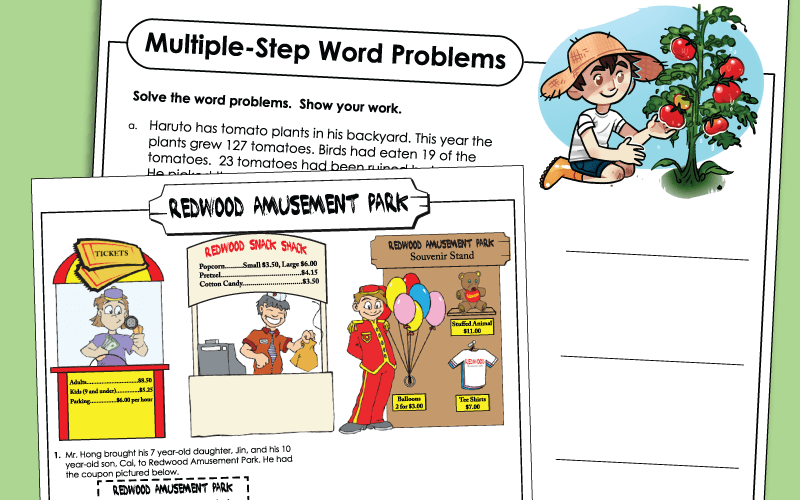
Basic (Grades 2 - 3)

Logged in members can use the Super Teacher Worksheets filing cabinet to save their favorite worksheets.
Quickly access your most used files AND your custom generated worksheets!
Please login to your account or become a member and join our community today to utilize this helpful feature.

Intermediate (Grades 3 - 4)

Advanced (Grades 4 - 5)
These word problems are sorted by type: addition, subtraction, multiplication, division, fractions and more.
These worksheets, sorted by grade level, cover a mix of skills from the curriculum.
S.T.W. has thousands of worksheets. Visit the full math index to find them all, sorted by topic.
Sample Images of Our Printables
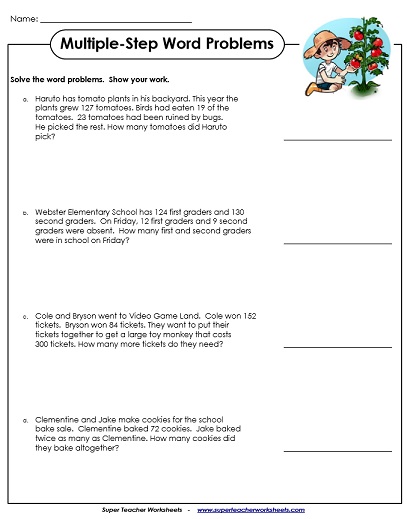
PDF with answer key:
PDF no answer key:

Addition & Subtraction Two-Step Word Problems - I
In this engaging math adventure, students will develop problem-solving skills as they learn strategies to solve two-step addition and subtraction word problems. They will explore the part-part-whole model and use equations to find solutions. Through interactive tasks, students will strengthen their understanding of mathematical concepts while having fun!

Know more about Addition & Subtraction Two-Step Word Problems - I

Your one stop solution for all grade learning needs.
two step problems Worksheets
- Kindergarten
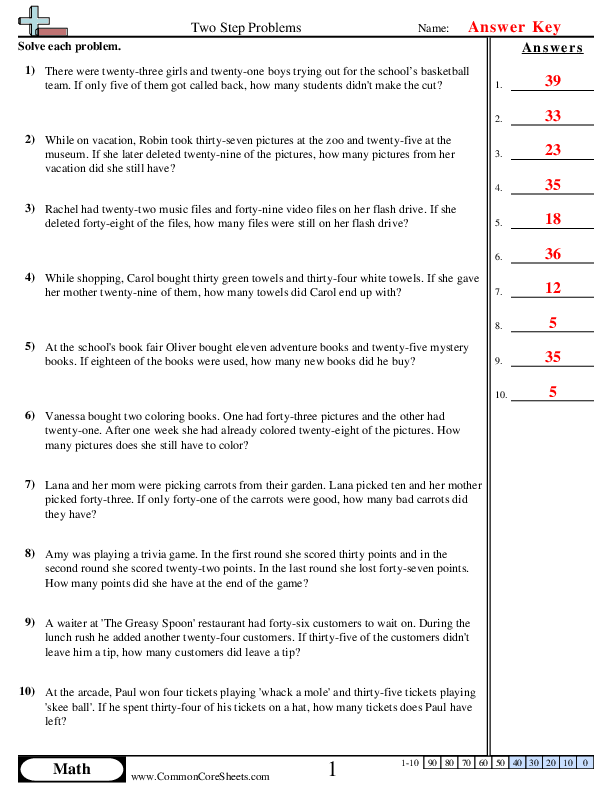
- Solve equations and inequalities
- Simplify expressions
- Factor polynomials
- Graph equations and inequalities
- Advanced solvers
- All solvers
- Arithmetics
- Determinant
- Percentages
- Scientific Notation
- Inequalities
What can QuickMath do?
QuickMath will automatically answer the most common problems in algebra, equations and calculus faced by high-school and college students.
- The algebra section allows you to expand, factor or simplify virtually any expression you choose. It also has commands for splitting fractions into partial fractions, combining several fractions into one and cancelling common factors within a fraction.
- The equations section lets you solve an equation or system of equations. You can usually find the exact answer or, if necessary, a numerical answer to almost any accuracy you require.
- The inequalities section lets you solve an inequality or a system of inequalities for a single variable. You can also plot inequalities in two variables.
- The calculus section will carry out differentiation as well as definite and indefinite integration.
- The matrices section contains commands for the arithmetic manipulation of matrices.
- The graphs section contains commands for plotting equations and inequalities.
- The numbers section has a percentages command for explaining the most common types of percentage problems and a section for dealing with scientific notation.
Math Topics
More solvers.
- Add Fractions
- Simplify Fractions
JavaScript is not active on your browser. This webite requires JavaScript in order to function.
Two-step word problems, addition, then subtraction.
Solve word problems that require two separate operations
Two-step word problems have three numbers which must be operated on separately, and in the right order. They take much more understanding of the problem than simple word problems because they provide the information in a less structured form. For these problems, finding the answer involves adding two numbers and then subtracting another number from the sum.
To revisit this article, visit My Profile, then View saved stories .
- The Big Story
- Newsletters
- Steven Levy's Plaintext Column
- WIRED Classics from the Archive
- WIRED Insider
- WIRED Consulting
OpenAI Announces a New AI Model, Code-Named Strawberry, That Solves Difficult Problems Step by Step

OpenAI made the last big breakthrough in artificial intelligence by increasing the size of its models to dizzying proportions, when it introduced GPT-4 last year. The company today announced a new advance that signals a shift in approach—a model that can “reason” logically through many difficult problems and is significantly smarter than existing AI without a major scale-up.
The new model, dubbed OpenAI o1, can solve problems that stump existing AI models, including OpenAI’s most powerful existing model, GPT-4o . Rather than summon up an answer in one step, as a large language model normally does, it reasons through the problem, effectively thinking out loud as a person might, before arriving at the right result.
“This is what we consider the new paradigm in these models,” Mira Murati , OpenAI’s chief technology officer, tells WIRED. “It is much better at tackling very complex reasoning tasks.”
The new model was code-named Strawberry within OpenAI, and it is not a successor to GPT-4o but rather a complement to it, the company says.
Murati says that OpenAI is currently building its next master model, GPT-5, which will be considerably larger than its predecessor. But while the company still believes that scale will help wring new abilities out of AI, GPT-5 is likely to also include the reasoning technology introduced today. “There are two paradigms,” Murati says. “The scaling paradigm and this new paradigm. We expect that we will bring them together.”
LLMs typically conjure their answers from huge neural networks fed vast quantities of training data. They can exhibit remarkable linguistic and logical abilities, but traditionally struggle with surprisingly simple problems such as rudimentary math questions that involve reasoning.
Murati says OpenAI o1 uses reinforcement learning, which involves giving a model positive feedback when it gets answers right and negative feedback when it does not, in order to improve its reasoning process. “The model sharpens its thinking and fine tunes the strategies that it uses to get to the answer,” she says. Reinforcement learning has enabled computers to play games with superhuman skill and do useful tasks like designing computer chips . The technique is also a key ingredient for turning an LLM into a useful and well-behaved chatbot.
Mark Chen, vice president of research at OpenAI, demonstrated the new model to WIRED, using it to solve several problems that its prior model, GPT-4o, cannot. These included an advanced chemistry question and the following mind-bending mathematical puzzle: “A princess is as old as the prince will be when the princess is twice as old as the prince was when the princess’s age was half the sum of their present age. What is the age of the prince and princess?” (The correct answer is that the prince is 30, and the princess is 40).
“The [new] model is learning to think for itself, rather than kind of trying to imitate the way humans would think,” as a conventional LLM does, Chen says.
OpenAI says its new model performs markedly better on a number of problem sets, including ones focused on coding, math, physics, biology, and chemistry. On the American Invitational Mathematics Examination (AIME), a test for math students, GPT-4o solved on average 12 percent of the problems while o1 got 83 percent right, according to the company.

The new model is slower than GPT-4o, and OpenAI says it does not always perform better—in part because, unlike GPT-4o, it cannot search the web and it is not multimodal, meaning it cannot parse images or audio.
Improving the reasoning capabilities of LLMs has been a hot topic in research circles for some time. Indeed, rivals are pursuing similar research lines. In July, Google announced AlphaProof , a project that combines language models with reinforcement learning for solving difficult math problems.
AlphaProof was able to learn how to reason over math problems by looking at correct answers. A key challenge with broadening this kind of learning is that there are not correct answers for everything a model might encounter. Chen says OpenAI has succeeded in building a reasoning system that is much more general. “I do think we have made some breakthroughs there; I think it is part of our edge,” Chen says. “It’s actually fairly good at reasoning across all domains.”
Noah Goodman , a professor at Stanford who has published work on improving the reasoning abilities of LLMs, says the key to more generalized training may involve using a “carefully prompted language model and handcrafted data” for training. He adds that being able to consistently trade the speed of results for greater accuracy would be a “nice advance.”
Yoon Kim , an assistant professor at MIT, says how LLMs solve problems currently remains somewhat mysterious, and even if they perform step-by-step reasoning there may be key differences from human intelligence. This could be crucial as the technology becomes more widely used. “These are systems that would be potentially making decisions that affect many, many people,” he says. “The larger question is, do we need to be confident about how a computational model is arriving at the decisions?”
The technique introduced by OpenAI today also may help ensure that AI models behave well. Murati says the new model has shown itself to be better at avoiding producing unpleasant or potentially harmful output by reasoning about the outcome of its actions. “If you think about teaching children, they learn much better to align to certain norms, behaviors, and values once they can reason about why they’re doing a certain thing,” she says.
Oren Etzioni , a professor emeritus at the University of Washington and a prominent AI expert, says it’s “essential to enable LLMs to engage in multi-step problem solving, use tools, and solve complex problems.” He adds, “Pure scale up will not deliver this.” Etzioni says, however, that there are further challenges ahead. “Even if reasoning were solved, we would still have the challenge of hallucination and factuality.”
OpenAI’s Chen says that the new reasoning approach developed by the company shows that advancing AI need not cost ungodly amounts of compute power. “One of the exciting things about the paradigm is we believe that it’ll allow us to ship intelligence cheaper,” he says, “and I think that really is the core mission of our company.”
You Might Also Like …
In your inbox: The best and weirdest stories from WIRED’s archive
Elon Musk is a national security risk
Interview: Meredith Whittaker is out to prove capitalism wrong
How do you solve a problem like Polestar ?
Event: Join us for The Big Interview on December 3 in San Francisco


COMMENTS
Two-Step Word Problems. Two-step word problems have three numbers which must be operated on separately, and in the right order. They take much more understanding of the problem than simple word problems because they provide the information in a less structured form. Two-Step Word Problems. Addition, then Subtraction; Addition, then Multiplication
Identify the first step and write an equation. First, you need to find out the total number of pieces Hannah dumped into the bowl from her two bags. 78 + 92 = x78 +92 = x. 2 Identify the second step and write an equation. Next, you need to add the total pieces that Hannah's friend dumped into Hannah's total from the previous step.
Two-Step Equations Exercises. Hone your skills in solving two-step equations because it will serve as your foundation when solving multi-step equations. I prepared eight (8) two-step equations problems with complete solutions to get you rolling. My advice is for you to solve them by hand using a pencil or pen and paper.
Two Step Equations Word Problems Worksheets. This two step word problems worksheet will produce ten problems per worksheet. You may select the numbers to be represented with digits or in words. You may increase the difficulty by selecting extra unnecessary information.
The USUAL way of solving a two-step equation: Note: This is the "usual" method because most of the two-step equations are solved this way.Notice that Step 2 can alternatively be replaced by Step 3 which are the same essentially. 1) First, add or subtract both sides of the linear equation by the same number. 2) Secondly, multiply or divide both sides of the linear equation by the same number.
Two step word problems - Common Core Standard (CCSS: 3.OA.8) Solve two-step word problems using the four operations. In this lesson you will learn to identify the operations in two step word problems. Example: The Davis family drove a total of 720 miles, starting on Friday and ending on Sunday. They drove 255 miles on Friday and 229 miles on ...
Word problems can make us nervous, but not if we break them down into smaller steps. This video shows how to use our knowledge of #addition, #subtraction, #m...
How to solve two-step word problems involving all four operations and assess the reasonableness of answers, examples and step by step solutions, Common Core Grade 3. ... Try the free Mathway calculator and problem solver below to practice various math topics. Try the given examples, or type in your own problem and check your answer with the ...
In a 2-step word problem, there are typically two operations that need to be performed in sequence. Perform the two operations. Check your answer to make sure it makes sense in the context of the problem. Have a look at this video if you need to learn how to solve 2-step word problems. Solving 2-step Word Problems
If this problem persists, tell us. Our mission is to provide a free, world-class education to anyone, anywhere. Khan Academy is a 501(c)(3) nonprofit organization. Donate or volunteer today! Site Navigation. About. News; Impact; Our team; Our interns; Our content specialists; Our leadership; Our supporters; Our contributors; Our finances;
Solve two-step word problemsIn this lesson you will learn how to solve two-step word problems by completing all of the steps.ADDITIONAL MATERIALSLesson slide...
Two step equations are algebraic problems that take just two steps to solve. The two step equation is a linear equation in one variable. While performing an operation for solving a two step equation, we need to perform the same operation on both sides of the equation. We isolate the variable on one side of the equation to determine its value.
Welcome to Solving Two-Step Equations with Mr. J! Need help with how to solve two-step equations? You're in the right place!Whether you're just starting out,...
Two-Step Equation Word Problems Date_____ Period____ 1) 331 students went on a field trip. Six buses were filled and 7 students traveled in cars. ... new math books. The cafeteria contributed four pies to the sale. Each pie was then cut into five pieces and sold. There were a total of 60 pieces to sell. How many pies did the
Multiple Step, Intermediate #2 FREE. These word problems have a farming theme. Students use critical thinking to determine which operations are required for solving each problem. 3rd through 5th Grades. View PDF. Multiple Step, Intermediate #3. Use addition and subtraction to solve each of these four story problems.
In this engaging math adventure, students will develop problem-solving skills as they learn strategies to solve two-step addition and subtraction word problems. They will explore the part-part-whole model and use equations to find solutions. Through interactive tasks, students will strengthen their understanding of mathematical concepts while ...
There was a confusing example in the original video. This is the updated version.This video shows students how to solve 2-step Algebra equations involving on...
3oa8 × Description: "This worksheet is designed to engage children in solving two-step math problems. It touches upon concepts such as multiplication, addition, and critical thinking, presented through real-world scenarios. The problems can be personalized, transformed into flashcards, or utilized in a distance learning setting to make learning math more interactive and fun."
QuickMath will automatically answer the most common problems in algebra, equations and calculus faced by high-school and college students. The algebra section allows you to expand, factor or simplify virtually any expression you choose. It also has commands for splitting fractions into partial fractions, combining several fractions into one and ...
Two-Step Word Problems Addition, then Subtraction. Solve word problems that require two separate operations. Two-step word problems have three numbers which must be operated on separately, and in the right order. They take much more understanding of the problem than simple word problems because they provide the information in a less structured ...
Solve a word problem involving running distance and speed using two equations. Watch a video explanation and practice with Khan Academy.
Learn how to solve word problems using two-step equations.For more Math help visit our websitehttp://www.moomoomath.com/
Oren Etzioni, a professor emeritus at the University of Washington and a prominent AI expert, says it's "essential to enable LLMs to engage in multi-step problem solving, use tools, and solve ...
Here's how we solve a two step equation. It begins with the concept of equality: what we do to one side of the equation must be done to the other.Watch the n...
In our tests, the next model update performs similarly to PhD students on challenging benchmark tasks in physics, chemistry, and biology. We also found that it excels in math and coding. In a qualifying exam for the International Mathematics Olympiad (IMO), GPT-4o correctly solved only 13% of problems, while the reasoning model scored 83%.